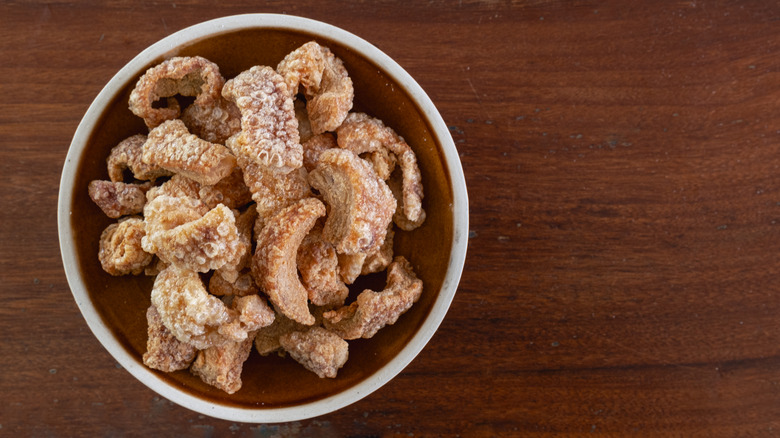Fried chicken may be one of the most experimented-with recipes from America. From MSG to Southern whiskey-fried chicken, it seems like just about every ingredient in the world has had its turn in the batter. But one crunchy gas station snack could be the end-all, be-all of fried chicken seasonings.
Pork rinds are cheap, tasty, and come in enough flavor varieties to suit any fried chicken recipe. While fried chicken already has plenty of hearty flavor from your choice of oil and cut of meat, pork rinds somehow retain their own inherent taste, making your golden brown creation even more satisfying. Even plain, unseasoned varieties are packed with enough umami to act as a substitute for MSG. And, of course, they’re already packed with oil from their own frying, so your fried chicken will basically taste like it was fried twice — without the risk of burning the crust.
The more complex your seasoning mix is, the fewer options you may have for which flavor of pork rinds to use. For example, a highly seasoned Cajun recipe may not pair well with barbecue or salt and vinegar rinds, but it’s still a great candidate for flavors that rely on a lot of peppers. While the flavor of pork rind is entirely up to your palate, there are a few universal best practices when including them in your crust.
How to add pork rinds to fried chicken
Much like giving cornbread a salty, crunchy, and flavorful touch with pork cracklings, you’ll first have to decide how finely to grind your pork rinds (known globally as chicharróns). Both coarse and fine textures have their own advantages and drawbacks, but it largely comes down to whether you want the pork rinds to replace some of your flour, season your breading, or add texture.
You can use finely ground pork rinds to replace flour in your breading, but keep in mind that most fried chicken recipes call for starches for a reason. When moisture from the chicken and wet ingredients combines with starches in hot oil, the heat binds the starches together while leaving small pockets that fill with oil, creating that signature fried food flavor and crunch. Since pork rinds have no significant starch content, treat them as a seasoning — one that enhances the flour rather than replaces it entirely.
If, however, you want to capitalize on that shatteringly crisp pork rind texture, grind them to a coarser consistency. When added to your dry ingredients, flecks of pork rinds retain much of their inherent crispiness, creating tiny pops of crunchiness with every bite. If you choose this method, it may be best to stick to smaller cuts of chicken, as larger cuts that require longer cooking times may cause the already-cooked pork rinds to burn.






